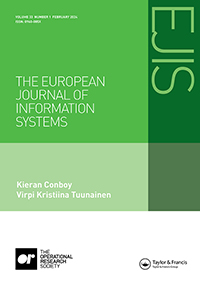Digital-Enabled Strategic Agility: The Next Frontier
IF 8.6
2区 管理学
Q1 COMPUTER SCIENCE, INFORMATION SYSTEMS
引用次数: 4
Abstract
As we approach the twentieth anniversary of the publication of the now-classic paper on strategic agility by Sambamurthy et al. (2003), we are reminded that information technology (IT) executives continue to view strategic agility as one of their most enduring challenges (Kappelman et al., 2021). Defined as the extent to which organisations can respond to sudden, disruptive, and unanticipated market events with ease, speed, and dexterity (Sambamurthy et al., 2003; Tallon et al., 2019), strategic agility has come of age in an era where organisations face a host of threats and opportunities from forces both seen and unseen. If done correctly, digital-enabled strategic agility can enable rapid, scalable, and cost effective changes in products, services, and processes but, if done poorly, the price of rigidity and delays can be inordinately high as oncelauded industry giants such as Sears, General Electric, Xerox, and Kodak have discovered (Collins, 2009). Our motivation for pursuing this special issue was prompted, in part, by a dearth of research on the topic of strategic agility in the literature. When writing a review paper on the subject in 2018 (Tallon et al., 2019), we uncovered 83 papers published across a variety of premier information systems (IS) journals and conferences between 2000 and 2018; three-fourths of this number appeared after 2009. Even then, less than five papers have been published annually on a topic that is garnering increased attention from IT executives for its ability to deliver greater customer satisfaction, employee engagement, and operational effectiveness (Kappelman et al., 2021). Our focus on strategic agility assumed a new air of importance in spring 2020 for no sooner had we sent out our Call for Papers than the COVID-19 pandemic struck. Organisations’ subdued response to the pandemic brought into sharp relief the need for fresh thinking on what it means to be “agile”. Organisations who were slow to pivot were mercilessly punished; retailers who relied heavily on foot traffic such as Brooks Brothers, Neiman Marcus, and JC Penney were especially vulnerable. Others such as Zoom, Uber Eats, Home Depot, Netflix, and Disney were able to scale and innovate around their existing processes and business models in order to remain relevant. Perhaps this time is different for the pandemic exposed the limits of what organisations could really do. For those who say that organisations could never have foreseen this calamitous event and so could never have planned an effective response, perhaps we should reconsider that logic so that we are better prepared next time. So what could we have done differently? We might also ask whether efforts to boost strategic agility are seen as just another IT problem for the IS function to resolve or whether strategic agility is an opportunity that warrants serious attention from all organisational leaders.数字化战略灵活性:下一个前沿
在我们即将迎来Sambamurthy等人(2003)发表的关于战略敏捷性的经典论文20周年之际,我们被提醒,信息技术(IT)高管继续将战略敏捷性视为他们最持久的挑战之一(Kappelman等人,2021)。战略敏捷性被定义为组织能够轻松、快速、灵活地应对突发、破坏性和出乎意料的市场事件的程度(Sambamurthy et al.,2003;Tallon et al.,2019),在组织面临来自看得见和看不见的力量的大量威胁和机遇的时代,战略敏捷性已经成熟。如果做得正确,数字化战略灵活性可以实现产品、服务和流程的快速、可扩展和成本效益的变革,但如果做得不好,僵化和延迟的代价可能会高得离谱,正如西尔斯、通用电气、施乐和柯达等备受赞誉的行业巨头所发现的那样(Collins,2009)。我们追求这一特刊的动机在一定程度上是因为文献中缺乏对战略敏捷性主题的研究。在2018年撰写一篇关于该主题的综述论文时(Tallon et al.,2019),我们发现了2000年至2018年间在各种主要信息系统(IS)期刊和会议上发表的83篇论文;这一数字的四分之三出现在2009年之后。即便如此,每年发表的论文还不到五篇,这一主题因其提供更高客户满意度、员工敬业度和运营效率的能力而越来越受到IT高管的关注(Kappelman等人,2021)。2020年春季,我们对战略敏捷性的关注呈现出新的重要气氛,因为我们刚发出文件呼吁,新冠肺炎疫情就爆发了。各组织对疫情的反应迟缓,让人们对“敏捷”意味着什么有了新的思考。行动迟缓的组织受到了无情的惩罚;布鲁克斯兄弟(Brooks Brothers)、内曼·马库斯(Neiman Marcus)和JC Penney等严重依赖人流的零售商尤其容易受到影响。Zoom、优步饮食、家得宝、网飞和迪士尼等其他公司能够围绕其现有流程和商业模式进行扩展和创新,以保持相关性。也许这一次不同了,因为疫情暴露了组织真正能做的事情的局限性。对于那些说组织永远无法预见这一灾难性事件,因此永远无法计划有效应对的人来说,也许我们应该重新考虑这一逻辑,以便为下一次做好更好的准备。那么,我们本可以采取什么不同的做法呢?我们还可能会问,提高战略敏捷性的努力是否被视为IS职能部门需要解决的另一个IT问题,或者战略敏捷性是否是一个值得所有组织领导人认真关注的机会。
本文章由计算机程序翻译,如有差异,请以英文原文为准。
求助全文
约1分钟内获得全文
求助全文
来源期刊

European Journal of Information Systems
工程技术-计算机:信息系统
CiteScore
23.10
自引率
4.20%
发文量
52
审稿时长
>12 weeks
期刊介绍:
The European Journal of Information Systems offers a unique European perspective on the theory and practice of information systems for a global readership. We actively seek first-rate articles that offer a critical examination of information technology, covering its effects, development, implementation, strategy, management, and policy.
 求助内容:
求助内容: 应助结果提醒方式:
应助结果提醒方式:


